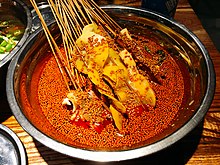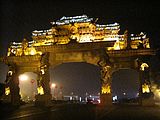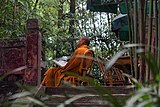Leshan
Leshan
乐山市 | |
|---|---|
Lizheng Gate Mabian Dafengding National Nature Reserve Wuyou Temple Shizhong Temple | |
 Location of Leshan City jurisdiction in Sichuan | |
| Coordinates (Seat of Leshan municipal government): 29°33′07″N 103°45′58″E / 29.552°N 103.766°E | |
| Country | People's Republic of China |
| Province | Sichuan |
| County-level divisions | 4 Counties, 2 Autonomous Counties, 1 County-level city and 4 Districts |
| Municipal seat | Shizhong District |
| Area | |
| 12,827.49 km2 (4,952.72 sq mi) | |
| • Urban | 1,918.5 km2 (740.7 sq mi) |
| • Metro | 836.1 km2 (322.8 sq mi) |
| Population (2020 census)[1] | |
| 3,160,168 | |
| • Density | 250/km2 (640/sq mi) |
| • Urban | 1,236,188 |
| • Urban density | 640/km2 (1,700/sq mi) |
| • Metro | 1,236,188 |
| • Metro density | 1,500/km2 (3,800/sq mi) |
| GDP[2] | |
| • Prefecture-level city | CN¥ 130.1 billion US$ 20.9 billion |
| • Per capita | CN¥ 39,973 US$ 6,418 |
| Time zone | UTC+8 (China Standard) |
| Postal code | 614000 |
| Area code | 0833 |
| ISO 3166 code | CN-SC-11 |
| Licence Plate Prefixes | 川L |
| Website | leshan |
| Leshan | |||||||||||||||||||||||
|---|---|---|---|---|---|---|---|---|---|---|---|---|---|---|---|---|---|---|---|---|---|---|---|
 "Leshan" in Simplified (top) and Traditional (bottom) Chinese characters | |||||||||||||||||||||||
| Simplified Chinese | 乐山 | ||||||||||||||||||||||
| Traditional Chinese | 樂山 | ||||||||||||||||||||||
| |||||||||||||||||||||||
| Jiading | |||||||||||||||||||||||
| Chinese | 嘉定 | ||||||||||||||||||||||
| |||||||||||||||||||||||
Leshan, formerly known as Jiading[a] and Jiazhou, is a prefecture-level city located at the confluence of the Dadu and Min rivers, on the southwestern fringe of the Sichuan Basin in southern Sichuan, about 120 km (75 mi) from the provincial capital of Chengdu. As of the 2020 census, its population was 3,160,168, of whom 1,236,188 lived in the built-up metro area made of Shizhong (downtown), Wutongqiao, Shawan and Jinkouhe districts. A historical and cultural city, Leshan is famous for world heritage sites Emei Mountain and Leshan Buddha.[4] It is also a regional center in the southern part of the Chengdu Economic Zone, serving as a transportation hub and port city in southwestern China.
History
[edit]Leshan has a long history, with written records tracing back to around 700 BC during the Kai Ming dynasty of the Shu Kingdom. Around the early Spring and Autumn period, the Ba people, led by Kai Ming Bie Ling, migrated from western Hubei and settled at the confluence of the three rivers in what is now Leshan, including present-day Fengzhouba and the Dadu River. They established a tribal center. From the Qin and Han dynasties through to the Wei and Jin dynasties, the central government set up Nan'an County, laying the foundation for the present-day Leshan region.[5]
After the Sui unification of China, Leshan was part of Meishan Prefecture (jun). In the third year of the Kaihuang reign (583 AD) of the Sui dynasty, the prefecture system was changed to a two-tier system of state (zhou) and counties. During the Tang dynasty's Zhenguan reign, Leshan became part of Jiazhou. In the Northern Song's Chongning reign, Leshan belonged to Jiading Prefecture, which administered five counties. During the reign of Emperor Ningzong of the Southern Song, Jiazhou was elevated to a prefecture and renamed Jiading Prefecture, marking the first use of the name "Jiading." During the Song and Yuan dynasties, Leshan's status rose from a prefecture to a province (lu), becoming the third-largest city in Sichuan, after Chengdu and Chongqing. In the twelfth year of Emperor Yongzheng's reign (1734 AD) of the Qing dynasty, Jiading Prefecture was established again.[5]
In the early years of the Republic of China, from 1912 to 1917, Leshan was restructured into a county under the jurisdiction of the Sichuan Provincial Governor's Office. After Yuan Shikai's death, Sichuan broke away from central authority; by 1918, Xiong Kewu took control of Sichuan, implementing the "Defense Zone System," which decentralized military, political, financial, and tax powers to local garrisons, leading to warlordism and prolonged unrest in the region for 18 years. During this time, Leshan was successively controlled by Chen Hongfan, Liu Wenhui, and Liu Xiang, with local officials appointed by the stationed troops.[5]
After the Mukden Incident, the Nationalist government relocated the treasures from the Forbidden City, Beijing to Shanghai, then Nanjing, and a significant portion eventually ended up in Leshan, including Emei and Angu, while the rest of them stored in Baxian (now Banan, Chongqing). The Forbidden City artifacts were stored in Leshan from July 1939, when the first batch arrived, until March 1947, when the last batch was transported out.[6] In addition, during the Second Sino-Japanese War, Wuhan University and Jiangsu Sericulture College moved to Leshan, Sichuan University to Mount Emei, National Central Academy of Arts and Crafts was established at Renjiaba in Leshan, and Fuxing Academy was founded at Wuyou Temple in Leshan. Wuhan University left Leshan in June 1946.[5]
After the founding of the People's Republic, some of the area of Leshan was ceded to Emeishan city in 1958.[7] Until 1978, Leshan had three districts of Shizhong (means downtown), Wutongqiao (literally 5-"tong"-bridge) and Shawan (literally sand bay).[8] In 1978, Leshan as a county-level city was formed.[7] In 1985, Leshan became a prefecture-level city, with Emeishan and other county level cities under the administration of Leshan.[8]
Culture
[edit]Tourist attractions
[edit]


In 1996, the Mount Emei Scenic Area, including the Leshan Giant Buddha, the largest stone-carved buddha in the world, which was declared a World Heritage Site by UNESCO. Next to the Leshan Giant Buddha is the Oriental Buddha Park, a privately run cultural theme park, featuring thousands of reproductions of Buddha statues and Buddhist themed carvings. Mount Emei is located within the county-level city of Emeishan, which is under the administrative jurisdiction of Leshan.
The ancestral home of Chinese writer, academic and politician Guo Moruo is preserved in the Shawan District of Leshan.[9]
Dialect
[edit]The Leshan dialect is distinct among the dialects in Sichuan province for retaining the entering tone, the fourth of the four tones in classical Chinese pronunciation, which most Sichuan dialects and Mandarin no longer uses. Unlike other Sichuan dialects, most of which are mutually understandable, the Leshan dialect is difficult for other Sichuan people to understand.
Food
[edit]
Falling into the Sichuan cuisine family, Leshan is noted for its food culture, especially its variety of street foods. Typical specialties include:
- Malatang (麻辣烫) - Hot and spicy soup
- Boboji (钵钵鸡)[10] - Bobo chicken
- Shaokao (烧烤) - Street barbecue
- Qianwei Baobing (犍为薄饼) - Qianwei Pancakes
- Doufunao (豆腐脑) - Leshan Style Tofu Soup
- Tianpiya (甜皮鸭) - Sweet-Skinned Duck
- Qiaojiao Niurou (翘脚牛肉) Leshan Style Beef Hotpot
- Xiba Doufu (西坝豆腐) Xiba Tofu[11]
- Mi Liang Gao (米凉糕) - A snack made with rice
Transport
[edit]There are Chengdu–Mianyang–Leshan intercity railway and Chengdu–Guiyang high-speed railway serving Leshan.
The G0512 Chengdu–Leshan Expressway with a total length of 160 kilometers, was finished on January 14, 2000. This Freeway has since become very important to the city's development.
Education
[edit]Leshan Normal University (乐山师范学院) and Leshan Vocational & Technical College (乐山职业技术学院) are two government-funded colleges in the city.
The Engineering&Technical College of Chengdu University of Technology (成都理工大学工程技术学院) is a non-government college, which was established in 2003.
Administrative divisions
[edit]| Map | |||||
|---|---|---|---|---|---|
| Name | Hanzi | Hanyu Pinyin | Population (2020 census)[12] |
Area (km²) | Density (/km²) |
| Shizhong District | 市中区 | Shìzhōng Qū | 814,597 | 825 | 987 |
| Shawan District | 沙湾区 | Shāwān Qū | 144,931 | 617 | 235 |
| Wutongqiao District | 五通桥区 | Wǔtōngqiáo Qū | 237,933 | 474 | 502 |
| Jinkouhe District | 金口河区 | Jīnkǒuhé Qū | 38,727 | 598 | 65 |
| Emeishan City | 峨眉山市 | Éméishān Shì | 419,107 | 1,168 | 359 |
| Qianwei County | 犍为县 | Qiánwéi Xiàn | 416,673 | 1,375 | 303 |
| Jingyan County | 井研县 | Jǐngyán Xiàn | 280,641 | 841 | 334 |
| Jiajiang County | 夹江县 | Jiājiāng Xiàn | 305,441 | 749 | 408 |
| Muchuan County | 沐川县 | Mùchuān Xiàn | 192,313 | 1,401 | 130 |
| Ebian Yi Autonomous County | 峨边彝族自治县 | Ébiān Yízú Zìzhìxiàn |
121,554 | 2,395 | 51 |
| Mabian Yi Autonomous County | 马边彝族自治县 | Mǎbiān Yízú Zìzhìxiàn |
188,251 | 2,383 | 79 |
Population
[edit]According to the sixth national census in 2010, the city's resident population stood at 3235,756,[13] a decrease of 88,383 or 2.66% over the fifth national census. The average annual decrease was 0.27 per cent. Of these, the male population is 1631206, or 50.41 per cent, and the female population is 1604,550, or 49.59 per cent. The sex ratio of the total population (100 females) is 101.66.The population aged 0-14 years is 452,148, or 13.97 per cent; the population aged 15-64 years is 2387,477, or 73.78 per cent; and the population aged 65 and over is 396,131, or 12.24 per cent. The Han Chinese population is 3075,481, accounting for 95.05 percent; the ethnic minorities are 160,275 or 4.95 percent; and the Yi population is 153,092 or 4.73 percent. In 2017, the city's registered population was 3.518 million, accounting for 3.86 percent of the province's total population; at the end of the year, the resident population was 3.272 million.
There are 41 ethnic groups in Leshan City. Han, Yi, Hui and Miao live in the world. Han nationality is the main, followed by Yi nationality, ethnic minorities about 113,000 people, accounting for 3.2 percent of the total population. Yi Nationality: A major minority nationality concentrated in the south of Ma Bian, Ebian Yi Autonomous County, and Jinkouhe District.
Geography and climate
[edit]Leshan City is located in central Sichuan Province, southwest of the Sichuan Basin. Meishan borders on the north, Zigong and Yibin in the east, Liangshan in the south, and Ya'an in the west. Leshan city is located in the transition zone from Sichuan basin to southwest mountainous area, the overall trend is high in southwest, low in northeast, with wide difference in height. Landforms are mountainous, hilly, Pingba three types, mainly mountainous.
Leshan has a monsoon-influenced humid subtropical climate (Köppen Cwa) and is largely mild and humid. Winter is short, mild and dry, with a January average of 7.4 °C (45.3 °F), and while frost may occur, snow is rare. Summers are long, hot and humid, with highs often exceeding 30 °C (86 °F), yet extended heat waves are rare. The daily average in July and August is around 26 °C (79 °F). Rainfall is light in winter and can be heavy in summer, and more than 70% of the annual total occurs from June to September.
The climate in the southwest mountainous area has obvious vertical differences and the climatic conditions are very complex, which is a region for the development of comprehensive agricultural management and three-dimensional agriculture in the region, the main production area of wood, tea, Chinese medicinal materials and other crops, and also a valuable tourism resource. Affected by the monsoon and the uplift of the terrain, the climate is humid and the rainfall is abundant.
| Climate data for Leshan, elevation 424 m (1,391 ft), (1991–2020 normals, extremes 1971–present) | |||||||||||||
|---|---|---|---|---|---|---|---|---|---|---|---|---|---|
| Month | Jan | Feb | Mar | Apr | May | Jun | Jul | Aug | Sep | Oct | Nov | Dec | Year |
| Record high °C (°F) | 19.3 (66.7) |
23.9 (75.0) |
32.5 (90.5) |
34.7 (94.5) |
36.5 (97.7) |
36.8 (98.2) |
37.6 (99.7) |
41.3 (106.3) |
36.3 (97.3) |
30.1 (86.2) |
25.7 (78.3) |
19.8 (67.6) |
41.3 (106.3) |
| Mean daily maximum °C (°F) | 10.3 (50.5) |
13.3 (55.9) |
18.3 (64.9) |
23.8 (74.8) |
27.3 (81.1) |
29.2 (84.6) |
31.3 (88.3) |
31.0 (87.8) |
26.5 (79.7) |
21.4 (70.5) |
17.0 (62.6) |
11.6 (52.9) |
21.8 (71.1) |
| Daily mean °C (°F) | 7.4 (45.3) |
9.8 (49.6) |
14.0 (57.2) |
18.9 (66.0) |
22.4 (72.3) |
24.6 (76.3) |
26.6 (79.9) |
26.3 (79.3) |
22.6 (72.7) |
18.2 (64.8) |
13.9 (57.0) |
8.9 (48.0) |
17.8 (64.0) |
| Mean daily minimum °C (°F) | 5.3 (41.5) |
7.4 (45.3) |
10.9 (51.6) |
15.3 (59.5) |
18.7 (65.7) |
21.3 (70.3) |
23.3 (73.9) |
23.0 (73.4) |
20.1 (68.2) |
16.1 (61.0) |
11.8 (53.2) |
7.0 (44.6) |
15.0 (59.0) |
| Record low °C (°F) | −1.7 (28.9) |
−1.9 (28.6) |
0.2 (32.4) |
4.9 (40.8) |
10.5 (50.9) |
15.3 (59.5) |
17.6 (63.7) |
17.3 (63.1) |
13.6 (56.5) |
5.3 (41.5) |
2.2 (36.0) |
−2.9 (26.8) |
−2.9 (26.8) |
| Average precipitation mm (inches) | 14.4 (0.57) |
21.9 (0.86) |
42.5 (1.67) |
85.2 (3.35) |
104.8 (4.13) |
146.1 (5.75) |
256.2 (10.09) |
295.8 (11.65) |
132.2 (5.20) |
59.9 (2.36) |
29.6 (1.17) |
13.7 (0.54) |
1,202.3 (47.34) |
| Average precipitation days (≥ 0.1 mm) | 9.7 | 10.2 | 12.9 | 14.3 | 14.5 | 16.4 | 15.5 | 15.0 | 15.9 | 16.4 | 9.6 | 9.1 | 159.5 |
| Average snowy days | 0.6 | 0.3 | 0 | 0 | 0 | 0 | 0 | 0 | 0 | 0 | 0 | 0.2 | 1.1 |
| Average relative humidity (%) | 80 | 77 | 73 | 72 | 71 | 77 | 79 | 79 | 82 | 84 | 81 | 82 | 78 |
| Mean monthly sunshine hours | 38.5 | 51.9 | 89.8 | 119.3 | 121.6 | 104.4 | 132.9 | 145.2 | 71.9 | 49.5 | 52.4 | 37.5 | 1,014.9 |
| Percent possible sunshine | 12 | 16 | 24 | 31 | 29 | 25 | 31 | 36 | 20 | 14 | 17 | 12 | 22 |
| Source 1: China Meteorological Administration[14][15]all-time extreme temperature[16] | |||||||||||||
| Source 2: Weather China[17] | |||||||||||||
Natural resources
[edit]Leshan City, located at the confluence point of Minjiang River, Dadu River, Qing Yi River, is a water-rich area.
- Water resources: 85.51 billion cubic metres
- Theoretical reserves of hydraulic resources: 7.9 million kilowatts
- Developable capacity: 5.75 million kilowatts
- Main hydropower stations: Gongzui hydropower station (700,000 kW), Tongjiezi hydropower station (600,000 kW)
Apart from water resources, Leshan has rich mineral reserves of phosphorus, halite, limestone, kaolin, natural gas, gypsum, dolomite, mineral water and mirabilite.
Gallery
[edit]- Leshan
-
Night view
-
Buddhist temple
-
Buddhist Monk in Leshan
-
Lingbao Pagoda
Sister cities
[edit] Hervey Bay, Queensland, Australia
Hervey Bay, Queensland, Australia Gilbert, Arizona, United States
Gilbert, Arizona, United States Ichikawa, Chiba, Japan,[18] established due to Leshan native Guo Moruo residing there for 10 years with his wife, Sato Tomiko.[19]
Ichikawa, Chiba, Japan,[18] established due to Leshan native Guo Moruo residing there for 10 years with his wife, Sato Tomiko.[19] Prachuap Khiri Khan,Thailand
Prachuap Khiri Khan,Thailand Issy-les-Moulineaux,France
Issy-les-Moulineaux,France
Notable person
[edit]Famous place
[edit]- Leshan Buddha
- Reclining Buddha
- Mount Emei
- Mahaoya Tomb
- Thousand Buddha Rock in the Jiajiang River
- Ebian Black Bamboo Gou
- Guo Moruo's hometown
- Luocheng Ancient Town
- Wutong Bridge
See also
[edit]Notes
[edit]References
[edit]- ^ "China: Sìchuān (Prefectures, Cities, Districts and Counties) - Population Statistics, Charts and Map".
- ^ 四川省统计局、国家统计局四川调查总队 (2016). 《四川统计年鉴-2016》. 中国统计出版社. ISBN 978-7-5037-7871-1.
- ^ T. S. Baynes, ed. (1878). "China". Encyclopædia Britannica. Vol. V (9th ed.). New York: Charles Scribner's Sons. pp. 626–672.
- ^ "Mount Emei Scenic Area, including Leshan Giant Buddha Scenic Area". whc.unesco.org. Retrieved 2024-09-12.
- ^ a b c d "乐山简史". www.leshan.gov.cn. Retrieved 2024-09-12.
- ^ www.fractal-technology.com. "故宫文物南迁史料馆". 故宫博物院. Retrieved 2024-09-12.
- ^ a b 乐山老县名考(十):乐山县. 三江都市报 (in Chinese (China)). 18 May 2013. Retrieved 11 March 2019.
- ^ a b 國務院關於同意四川省撤銷樂山地區實行市管縣給四川省人民政府的批覆 (PDF). 中华人民共和国国务院公报 [People's Republic of China State Council Gazette] (in Chinese (China)). 1985 (10). State Council: 286. 20 April 1985. Retrieved 11 March 2019.
- ^ Leshan -- Home of World's Largest Stone Buddha Statue
- ^ "Leshan Food, Best Dishes and Snack of Leshan".
- ^ Leshan Cuisine
- ^ "乐山市第七次全国人口普查公报(第1-6号)" [Leshan City Seventh National Population Census Bulletin] (in Chinese). 2021-06-07.
- ^ 乐山市统计局. 《乐山市2010年第六次全国人口普查主要数据公报》.
- ^ 中国气象数据网 – WeatherBk Data (in Simplified Chinese). China Meteorological Administration. Retrieved 14 April 2023.
- ^ 中国气象数据网 (in Simplified Chinese). China Meteorological Administration. Retrieved 14 April 2023.
- ^ "Extreme Temperatures Around the World". Retrieved 2024-11-22.
- ^ 乐山 - 气象数据 -中国天气网 (in Chinese). Weather China. Retrieved 21 November 2022.
- ^ 楽山市 [Leshan City]. Ichikawa City Government. Archived from the original on 2009-08-28. Retrieved 2016-03-02.
- ^ City of Ichikawa: Leshan City Archived 2009-08-28 at the Wayback Machine
External links
[edit] Leshan travel guide from Wikivoyage
Leshan travel guide from Wikivoyage- Official Government Website
















